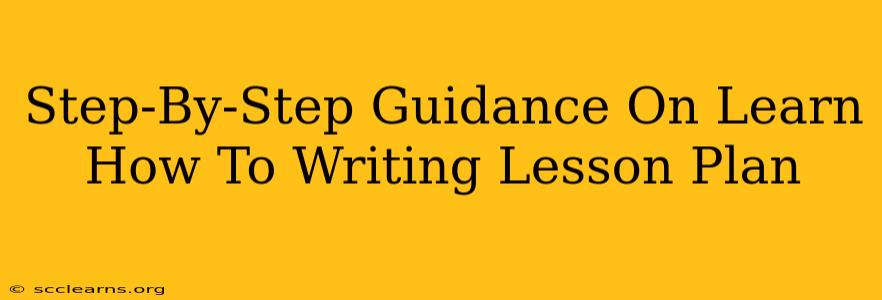Creating effective lesson plans is a crucial skill for any educator, whether you're a seasoned teacher or just starting out. A well-structured lesson plan ensures your teaching is engaging, focused, and achieves its learning objectives. This guide provides a step-by-step approach to crafting compelling lesson plans that truly make a difference.
Understanding the Importance of Lesson Planning
Before diving into the process, let's understand why lesson planning is so important. A well-designed lesson plan:
- Provides structure and focus: It keeps you on track during the lesson, ensuring you cover all essential topics.
- Enhances student engagement: A well-planned lesson is more likely to be engaging and stimulating for students.
- Facilitates effective teaching: It helps you anticipate potential challenges and adapt your teaching accordingly.
- Improves learning outcomes: A clear plan directly contributes to better student understanding and achievement of learning objectives.
- Aids in assessment: The plan helps you determine how you'll assess student learning and whether your teaching strategies were successful.
Step-by-Step Guide to Writing a Lesson Plan
Now, let's break down the process of writing a lesson plan into manageable steps:
1. Define Learning Objectives
This is the foundation of your lesson plan. What specific knowledge, skills, or attitudes do you want your students to gain by the end of the lesson? Use the SMART criteria:
- Specific: Clearly state what students will be able to do.
- Measurable: How will you assess whether students have achieved the objectives?
- Achievable: Are the objectives realistic for your students' abilities and the time allocated?
- Relevant: Are the objectives aligned with the curriculum and students' needs?
- Time-bound: Can the objectives be achieved within the allocated lesson time?
Example: Instead of "Students will learn about photosynthesis," try "Students will be able to explain the process of photosynthesis using a diagram and label the key components with 80% accuracy."
2. Identify the Target Audience
Knowing your students' prior knowledge, learning styles, and needs is vital. Consider factors like age, learning abilities, and cultural backgrounds. This helps you tailor your lesson to their specific needs and make it more relevant and engaging.
3. Choose Appropriate Teaching Methods and Activities
Select teaching methods and activities that align with your learning objectives and cater to your students' diverse learning styles. Consider using a variety of methods to keep students engaged and promote active learning. This could include:
- Direct instruction: Lectures, demonstrations.
- Interactive activities: Group work, discussions, games.
- Hands-on activities: Experiments, projects, role-playing.
4. Select Materials and Resources
Gather all the necessary materials and resources beforehand. This ensures a smooth and efficient lesson delivery. Resources could include:
- Textbooks and workbooks: Ensure they are appropriate for the students' level.
- Visual aids: Presentations, videos, images.
- Technology: Interactive whiteboards, computers, tablets.
- Handouts and worksheets: Provide students with clear instructions and activities.
5. Plan the Lesson Procedure
Outline the sequence of activities for your lesson. This should include:
- Introduction (5-10 minutes): Engage students with a captivating hook. Review prior knowledge.
- Development (20-30 minutes): Present new information using chosen teaching methods. Incorporate various activities.
- Practice (10-15 minutes): Provide opportunities for students to practice the new skills or knowledge.
- Assessment (5-10 minutes): Check for understanding using questions, quizzes, or other assessment methods.
- Closure (5 minutes): Summarize key points. Assign homework or further activities.
6. Plan for Differentiation
Not all students learn at the same pace or in the same way. Plan for differentiation by offering varied activities and support to cater to diverse learning styles and needs. This could include:
- Providing extra support for struggling students.
- Offering extension activities for advanced learners.
- Using different modalities to present information (visual, auditory, kinesthetic).
7. Review and Revise
Before implementing your lesson plan, review it to ensure clarity, consistency, and feasibility. Be prepared to adapt your plan as needed based on student responses and classroom dynamics.
Conclusion: The Ongoing Process of Improvement
Lesson planning is an iterative process. Reflect on your teaching after each lesson. What worked well? What could be improved? By regularly reviewing and refining your lesson plans, you'll become a more effective and engaging teacher. Remember, effective teaching is a journey of continuous learning and improvement.

